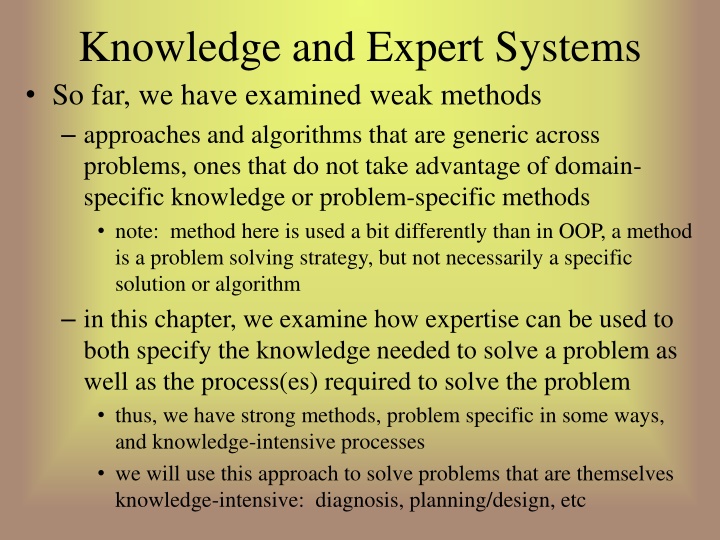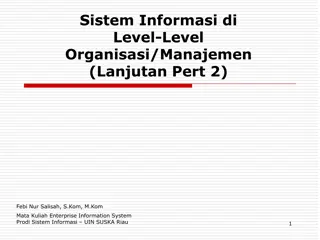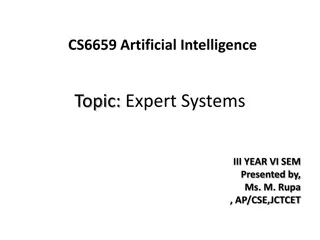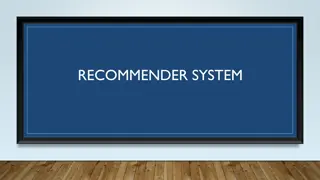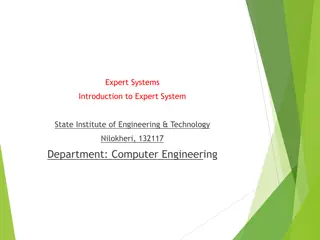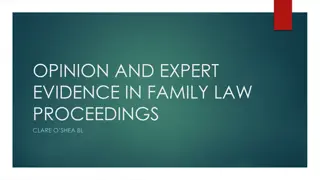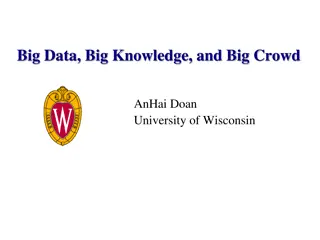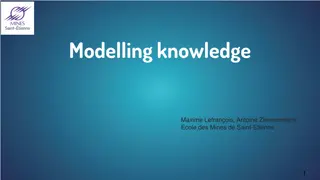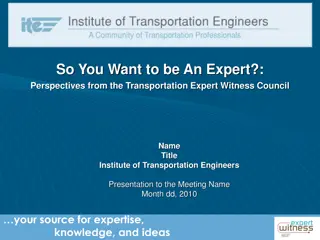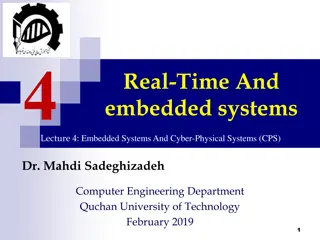Knowledge and Expert Systems
In this chapter, we delve into the realm of expert systems, which leverage specific knowledge to tackle intricate problems like diagnosis and planning. Expert systems, also known as knowledge-based systems, mimic human expert problem-solving by emphasizing the knowledge they utilize. These systems excel in reasoning processes, allowing easy skill modifications and heuristic-driven reasoning. Explore the various problem categories expert systems handle, from data interpretation to control and monitoring.
Download Presentation

Please find below an Image/Link to download the presentation.
The content on the website is provided AS IS for your information and personal use only. It may not be sold, licensed, or shared on other websites without obtaining consent from the author.If you encounter any issues during the download, it is possible that the publisher has removed the file from their server.
You are allowed to download the files provided on this website for personal or commercial use, subject to the condition that they are used lawfully. All files are the property of their respective owners.
The content on the website is provided AS IS for your information and personal use only. It may not be sold, licensed, or shared on other websites without obtaining consent from the author.
E N D
Presentation Transcript
Knowledge and Expert Systems So far, we have examined weak methods approaches and algorithms that are generic across problems, ones that do not take advantage of domain- specific knowledge or problem-specific methods note: method here is used a bit differently than in OOP, a method is a problem solving strategy, but not necessarily a specific solution or algorithm in this chapter, we examine how expertise can be used to both specify the knowledge needed to solve a problem as well as the process(es) required to solve the problem thus, we have strong methods, problem specific in some ways, and knowledge-intensive processes we will use this approach to solve problems that are themselves knowledge-intensive: diagnosis, planning/design, etc
Expert System An expert system is an AI system that solves a problem like a human expert or that requires the use of expert knowledge Today, we refer to these systems as knowledge-based systems because the emphasis is on the knowledge that they employ, not necessarily on expert knowledge or expert problem solving systems that require knowledge may not solve the problem like an expert for instance, daily planning does not require expertise in planning or human activities while we will use the term expert system throughout the chapter, it is synonymous with knowledge-based system Expert systems in general support inspection of their reasoning process (can explain or justify their conclusions) allow easy modification in adding and deleting skills from the knowledge base reason heuristically (with imperfect knowledge)
Expert System Problem Categories Interpretation given raw data, draw conclusion about the data recognition from data, test result interpretation Diagnosis determine the cause of the malfunction(s) given the observable symptoms Recognition identify the specific item(s) in the given data (whether this is visual, auditory or other) the above three problems are all forms of credit assignment problems Monitoring a form of interpretation to make sure a system s behavior matches the expectations Control related to monitoring, making changes to a system so that the behavior continues as expected even under unusual (erroneous, malfunction) situations
Continued Planning/Design devise a sequence of actions/configurations of plan steps/component parts to achieve some set of goals a plan is an abstract design with goals that are achieved when the plan is implemented components in a plan/design have functions that, when combined, achieve the given goal such that each component fulfills some subgoal(s) plans/designs have constraints and specifications Prediction projecting probable outcomes of given situations Instruction a tutorial that assists with the education process often requires modeling the user s belief state(s) and diagnosing why some beliefs are wrong
Knowledge-based Engineers Software engineering owes much of its early existence to AI which pioneered the large-scale system construction early AI systems were toy systems, written in Lisp (or whatever language) by the researchers themselves By the 1970s, expert systems were being constructed large scale endeavors, taking many man-years to produce often built from scratch in Lisp, the programmers needed to have knowledge of programming, knowledge representations, and domain knowledge acquired from domain experts A clear subdivision was made between the programmers and the domain experts who were brought it to impart their expertise these programmers were given the title knowledge-based engineers (KBE) they pioneered prototyping, programming tools, iterative lifecycle construction, and other concepts now found in SE
Expert System (ES) Architecture Below is the basic architecture of any expert system the interface is largely unimportant, what we need to concentrate on is the inference engine and the knowledge base (KB) including the form(s) of representation and the specific knowledge included The explanation subsystem and case-specific data are optional The knowledge base editor is only included if non KBEs will be editing the KB
Inference Engine What steps (processes) will the ES take when problem solving? this makes up the inference engine the typical form of knowledge representation was the rule (if-then statement) so typical inference engine either employed forward or backward chaining there are many other alternatives control mechanisms would be added to the inference engine both to provide a more efficient system and use problem specific forms of reasoning conflict resolution focus of attention on knowledge focus of attention on subproblems (e.g., data gathering, reasoning, explanation, treatment) recover from error by employing failure handling techniques learning capabilities (e.g., to save the solution in a case library)
KBE Development Cycle We should first determine if the problem is even one that should be solved by this approach does this problem require domain knowledge and symbolic reasoning? is human expertise available? does the need for the system justify the cost in building it? is the problem of reasonable size and scope? is the problem s domain well enough structured so that both domain knowledge and problem solving methods are available?
The Rule Based Approach Whether explicitly enumerated as if-then statements, or captured as predicate clauses, much knowledge comes in the form of a rule so much of AI revolved around rule-based systems as already noted, Mycin was such a success that the Emycin shell was developed (and later, OPS5 and others) ES construction could be as simple as: collect all domain knowledge in the form or rules decide on forward or backward chaining (and thus select OPS5 or Emycin) enumerate the rules in the selected language run, test, debug, enhance until done Many systems were developed in this fashion from SACON to R1/XCON to GUIDON (based on MYCIN, taught medical students about performing diagnosis) to ONCONCIN (drug treatment prescription and management for cancer patients) to TATR (tactical air targeting system for the Air Force)
Example: Automotive System Rule 1: if then the engine is getting gas, and the engine will turn over, the problem is spark plugs. Rule 2: if then the engine does not turn over, and the lights do not come on the problem is battery or cables. Rule 3: if then the engine does not turn over, and the lights do come on the problem is the starter motor. Rule 4: if then there is gas in the fuel tank, and there is gas in the carburetor the engine is getting gas.
Running the System Gas in fuel tank? Yes Gas in carburetor? Yes Engine will turn over? Why Here, we see a session The system is trying to match a rule by asking questions pertaining to the conditions It has been established that: 1. The engine is getting gas, 2. The engine will turn over, Then the problem is the spark plugs. The user may ask why in response to a question to find out why the system is asking that question that is, what information is the system working on and why is it important? How the engine is getting gas This follows from rule 4: If gas in fuel tank, and gas in carburetor then engine is getting gas. gas in fuel tank was given by the user gas in carburetor was given by the user The system responds by displaying the rule in an English-like way and what it is trying to establish at this point in time
Rules as an And/Or Graph We segment the rules into classifications If the rule(s) of a node is(are) true, then descend that branch If not, prune away that branch This allows us to focus only on the relevant rules rather than re-examining all of the rules in every iteration of the rule-based algorithm Left nodes are diagnostic conclusions
Data-Driven vs. Goal-Driven Most diagnostic systems take a data-driven approach start with the known data (observations, symptoms) and chain through the rules to conclusions what caused those symptoms? Mycin is an exception, it performed Goal-driven reasoning with the goal of treating an illness, so the main goals were diagnose and treat, but we won t worry about that Planning is often a goal-driven approach start with the goals (what are trying to plan or design?) and then select rules to help us select the actual plan steps or design components, and then configure them always working from larger concepts to more specific components/steps R1/XCON is an exception being data-driven by starting with the data the user specs So, in general, we will use data-driven for problems that start with data (diagnosis, interpretation) and goal-driven for problems that start with goals (planning, design)
Rule-based Control The simple Rule-based system relies solely on a conflict resolution strategy for control, this may not be sufficient and may not adequately mimic the expert problem solver the best idea is to break the problem into phases and have rule groupings that model this in a diagnostic situation, it might be data gathering and completion initial hypothesization further test ordering hypothesis refinement and confirmation treatment Mycin had phases like this, but were implicitly posed by organizing rules so that the system would not move on until a rule had stated that the current phase was over we might want to have rules that reason over the status of the problem and then shift the focus to a subset of rules within that focus but when does the system apply this metaknowledge versus working within the current focus?
Alternatives to Rules Rule-base is the only one way to implement a diagnostic reasoner most diagnostic reasoners will contain rules, but they do not have to be constructed solely of rules Object (frame) approach PUFF to diagnose pulmonary disorders, each disorder was represented as an object and organized in a hierarchy each frame had rules to determine that particular disorder s relevance (ask these questions and if the answers are as expected, continue down that branch of the class hierarchy) Classification organize diagnostic categories as nodes in a hierarchy associate with each node the questions necessary to establish that category perform a top-down search, pruning away categories and their subtrees that cannot be established heuristic classification, hierarchical classification Decision trees diagnostic categories are leaf nodes of a tree, each interior node is a decision made based on the response of a question (e.g., does the motor start? , do the lights come on?
Puff Detail Sample rule (RULE31) IF: 1. The severity of obstructive airways disease of the patient is greater than or equal to mild, and 2. the degree of diffusion defect of the patient is greater than or equal to mild, and 3. the TLC observed/predicted of the patient is greater than or equal to 110, and 4. the observed/predicted difference in RV/TLC of the patient is greater than or equal to 10 THEN: 1. There is strongly suggestive evidence (0.9) that the subtype of obstructive airways disease is emphysema, and 2. It is definite (1.0) that "OAD, Diffusion Defect, elevated TLC, and elevated RV together indicate emphysema" is one of the findings Originally built using E-Mycin, it was re-implemented as Centaur using a frame-based implementation with rules embedded into frames This approach is known as hierarchical hypothesize and test
Hierarchical Classification Ex. Engine Trouble Engine Trouble Fuel Fuel Electrical Electrical Air and Exhaust Air and Exhaust Spark Spark Control Control Oxygen Sensor Oxygen Sensor Fuel Pump Fuel Pump Relay Relay EGR Valve Solenoid Solenoid EGR Valve Spark Plug Spark Plug Battery Battery Mass Air Flow Sensor Mass Air Flow Sensor Spark Plug Wire Wire Spark Plug Voltage Regulator Regulator Voltage Air Filter Air Filter Throttle Position Sensor Throttle Position Sensor Fuel Pump Fuse Fuel Pump Fuse Catalytic Converter Converter Catalytic Ignition Coil Ignition Coil Knock Sensor Knock Sensor Fuel Pump Fuel Pump Manifold Absolute Pressure Sensor Pressure Sensor Manifold Absolute Idle Air Control Idle Air Control Solenoid Solenoid Fuel Injector Fuel Injector Manifold Air Manifold Air Temperature Sensor Temperature Sensor Fuel Pressure Fuel Pressure Regulator Regulator Idle Speed Control Motor Motor Idle Speed Control Coolant Temperature Coolant Temperature Sensor Sensor Fuel Filter Fuel Filter Engine Control Module Engine Control Module Crankshaft Position Sensor Crankshaft Position Sensor Camshaft Position Sensor Camshaft Position Sensor Vehicle Speed Sensor Vehicle Speed Sensor
Knowledge Acquisition and Modeling ES construction used to be a trial-and-error sort of approach with the KEs once they had knowledge from the experts, they would fill in their KB and test it out By the end of the 80s, it was discovered that creating an actual domain model was the way to go build a model of the knowledge before implementing anything A model might be a dependency graph of what can cause what to happen or an associational model which is a collection of malfunctions and the manifestations we would expect to see from those malfunctions or a functional model where component parts are enumerated and described by function and behavior The emphasis changed to knowledge acquisition tools (KADS) domain experts enter their knowledge as a graphical model that contains the component parts of the item being diagnosed/designed, their functions, and rules for deciding how to diagnose or design each one
The KBE Cycle with KADS Expert provides the model through KADS approach KE builds KB based on domain model Inference engine may be off the shelf or tailor-made or some combination based on choice of KE
Why Models? Rules generally represent causal reasoning If you see X then conclude it was caused by Y A model will show that Y causes X Example: If patient is confused and has unequal pupils then conclude stroke If stroke patient then patient is confused and pupils are unequal There might be many reasons why X arises With associational knowledge we may assume the wrong cause With a model, we can reason about all possible cause to effect results to have a broader, more comprehensive diagnosis The level of specificity of the model will determine the model s usefulness A shallower or less complete model may not be as useful as a deeper or more complete model The larger the model, the longer it takes to create and debug
Types of Models Models can vary depending on the type of problem being solved no model will be all-inclusive for instance, we would not construct a model that is used for both design and diagnosis (although we should!) One early approach was the qualitative model describe a device by its components and their behaviors but the description is not mathematically precise, instead it is based on qualitative state changes for instance, if the water is on, then the water pressure increases and the amount of water in the basin increases until filled if the basin is full and water is added, it overflows general diagnosis can be performed with a reasonable qualitative model so that we do not need one that is 100% complete or accurate while this approach will work in some domains, in general, it is not going to be specific enough
Model-Based Reasoning We model the domain/device causally and structurally Here, we have a device of 5 inputs and 2 outputs The device uses 3 multipliers and 2 adders Given the inputs (as shown), we expect F to be 12 and G to be 12 but F is 10, what could lead to this error? {M1}, {M2}, {M1, M2}, {A1}, {M1, A1}, {M2, A1}, {M1, M2, A1} We don t know enough for a definitive solution but what if we assume that there is only 1 fault? We can rule out M2 because G is correct so the error must either be M1 or A1 If we had probabilities of faults, we could use that to find the most likely fault
A NASA Example Here, we view a better model developed by NASA for a Livingston propulsion system a reactive self-configuring autonomous system knowledge modeled using propositional calc (instead of predicate calc there are a finite number of elements, each will be modeled by its own proposition) Helium is the fuel tank Oxidizer is mixed to cause the fuel to burn Acc is the accelerometer which, along with sensors in the valves, is used as input to control the system Pryo valves are used as control once they Change state, they stay in that state so they are used to change the flow of fuel when an error is detected, opening or closing a new pathway from tank to engine
Model (Architecture) for the System The idea is that the configuration manager tries to keep the spacecraft moving but at the lowest cost configuration Sensors feed into the ME (mode estimator) to determine if the system is functioning and in the lowest configuration If not, the MR (mode reconfiguration) plans a new mode by determining what valves to open and close Since this is a spacecraft, the output of the MR is a set of actions that cause valves to open or close directly The high level planner generates a sequence of hardware configurations goals such as the amount of propellant that should be used , it is the configuration manager that must translate these goals into actions
Variation of MBR: Functional Representation We model the system structurally like we have previously, but we model each component functionally (what its function is) and behaviorally (how the function is derived) this gives us a hierarchical design in that components are themselves represented functionally and their components are represented functionally some behaviors are specified as laws such as law of gravity or Kirchoff s law there are several function types toMake the device s function is to produce something toMaintain the device s function is to keep a state at its current level toPrevent the device itself might only operate when certain conditions arise and its function is to keep one or more values from reaching a specified level toControl a combination of the three
With this type of representation, we can reason about what would happen if or try to pinpoint the failure based on which function(s) is(are) occurring and which is(are) not
Case-Based Reasoning Another form of reasoning is to draw on an actual previously existing solution and adapt it as much as possible to fit the new problem the process works like this, given a problem select from among a library of previous cases (solutions), one that meets the same specifications compare the selected case s results to the desired results and find the differences modify the case appropriately apply the transformed case if successful, capture the new solution as a case and save it in the library otherwise repeat the entire process by selecting another case to try The original CBR system was Chef given a library of recipes input a desired meal specification (type of dish to prepare, taste, texture, method of cooking) select a previous recipe and alter it to meet the new specification(s) test the new recipe and if successful, save it otherwise modify it until it passes the test
More on Chef the Chef architecture is shown here sorry about the poor quality of this image! The Anticipator would generate potential problems (predictions) from the input specification (the goals) Modification rules would include two forms: structural changes to the meal (additional items, reordered items) and ingredient critics (substitutions for any food item)
Example Knowledge in Chef Here we see the two forms of knowledge as examples (in Lisp) a structural modification says that a souffle with fruit should be performed in these three steps: chop the fruit up into pulp sized units, pour the contents of the souffle into the baking dish, then mix the fruit in a critic that specifies that shrimp, if in a recipe, might be shelled before it is cooked (add:mod index (fruit style-souffle) amount (cup number (1)) steps ((do (chop object ?new-item size (pulp))) (before (pour object ?object into (nine-inch-baking-dish)) do (mix object ?new-item with ?object)))) (add:crit shrimp binds (shrimp *new-item*) steps ((before (cook-step object *new-item*) do (shell object *new-item*))))
Critiquing and Fixing the Recipe Once a recipe is generated, we need to test it critiquing knowledge will check the recipe for logic and then suggest critics (like the two previous rules) to make alterations Lets look at a complete example user input: stir-fry dish, include beef, include broccoli Chef retrieves stir-fry dish with chicken and green beans (both broccoli and green beans are green vegetables, so the match is approximate) Chef applies modification rule to substitute broccoli for green beans and applies ingredient critic to add chopping step and adjust cooking time resulting recipe (see next slide) is tested and it is discovered that beef releases water dry wok condition is disabled, a repair strategy is retrieved for this problem of the form split-and-reform that is, split the cooking step of beef and broccoli into two steps, then add them at the end the revised plan is tested and passes the final recipe is saved as a new dish
The Final Recipe After Repair Obviously, Chef is not very interesting but CBR has found uses in problems as diverse as bioprocess planning and military force deployment CBR offers a primitive form of learning by remembering our new solutions, we build upon our knowledge There are a number of difficulties with CBR capturing appropriate adaption knowledge, indexing and selection of partially matching plans Ingredients: 1/2 pound beef, 1 tsp sugar, 2 Tbs soy sauce, 1/2 lb. Broccoli, 1 tsp rice wine,1 tsp salt, 1/2 tsp corn starch,1 clove garlic Chop garlic into pieces the size of matchheads. Shred beef. Marinate beef in garlic, sugar, corn starch, rice wine and soy sauce. Chop the broccoli into chunks. Stir fry spices, rice wine and beef for 1 minute. Add broccoli to spices, rice wine and beef. Stir fry spices, rice wine, broccoli and beef for 3 minutes. Add salt.
Indexing and Retrieval of Cases Kolodner, one of the leading CBR researchers, proposes the following heuristics goal-directed preference organize cases (at least in part) by goal descriptions and retrieve cases with the same goals as the current situation salient-feature preference prefer cases that match the most important features or the largest number of matching features specify preference look for as exact a match as possible frequency preference check the most frequently matched cases first recency preference check the most recently matched cases first ease of adaption preference use the cases that are most easily adapted to the current situation the last one is very similar to salient-feature preference where the salient features are those that require the greatest amount of modification that is, if we find a case that matches those features that would be the most significant to change, then it is both the most salient and easiest to adapt
Comparing Approaches We have looked at various forms of rule-based reasoning, case-based reasoning and model-based reasoning while there might be some overlap between them, they have enough differences that a KBE needs to make an early choice of the approach to use so what approach should be used? Rule-based approach easy to capture knowledge as rules rules lead to an easy explanation facility which can help with debugging rules allow a clean separation between knowledge and process to control the system but, rules are only useful when they can be kept to a reasonable number (no more than a few thousand) and/or can be clearly subdivided into groups, they tend to be brittle (an ES based on rules can break easily because it has no underlying knowledge) the system s accuracy will degrade rapidly when tested at the limits of its knowledge and rules tend to be more associational than functional and this can lead to faulty reasoning
Comparison Continued rules also do not permit easy expansion of knowledge you have to have a very thorough knowledge of the previous rules before you can add to them or else you might add contradictory knowledge CBR no need for knowledge acquisition, merely provide the system with an ample set of initial cases system can learn and improve, allows shortcuts in reasoning, and exploit past successes to get past potential erroneous situations and does not require an extensive amount of domain knowledge but cases do not deepen the knowledge of the system, only provide alternative choices, and a large number of cases can lead to poorer performance and finally, indexing and retrieval remain large problems
Comparison Continued Model-based the application of functional/structural knowledge is superior to associational knowledge and increases the robustness of the system (less brittleness), being able to reason from first principles, and such a system can provide an even better explanation than a rule-based system creating an explicit domain model is very challenging and in many domains, not possible (e.g., we do not understand the human body well enough for an appropriate diagnostic model!), and such a model can be highly complex leading to poor efficiency and/or poor accuracy and in some cases, exceptional situations, that could be handled by a simple rule, cannot be modeled
Diagnosis vs. Planning As already described, diagnosis is typically a data-driven problem and planning is goal-driven The idea behind planning is to generate a sequence of operations that, when taken, will fulfill the given goals so the process is one of given goals and generating operators in a proper sequence like previous problems, we can view this as a state space to search, but we can be more intelligent about how we generate our plan to reduce the complexity instead of viewing it as a state space like a tree, we will instead use a production-system type of approach all of our operations will have preconditions to tell us if the given action is applicable at this state of the problem postconditions to tell us what goals they can fulfill when applied
Planning by Subgoaling This lets us view planning as a process of subgoaling given a goal find an operator that accomplishes that goal but the operator must first be in the proper state before it can be selected generate the conditions that need to be true to select that operator these are new goals, or subgoals add these subgoals to our list of goals repeat until the conditions are met by the initial state We may use a goal stack to accomplish goal g1, we select operator o1, which itself requires goals g2 and g3, so we push g2 and g3 on to the stack when we eventually solve g3, we pop it off the stack, when we accomplish g2, we pop it off the stack, now we can pop g1 off the stack because we accomplished the preconditions for o1 and thus g1
Example: Blocks World Robot Operators: goto(x, y, z) move robot to location x, y, z pickup(w) pickup the block w, block w must be clear and robotic hand empty to apply this operator putdown(w) place w on the table, block w must already be in the robotic hand stack(u, v) stack block u on top of block v, block u must already be in the robotic hand and v must be clear unstack(u, v) place block u in the robotic hand, block u must be clear and on top of v and the robotic hand must be empty A state of the world may be given using predicates like on(b, a), on(c, b), ontable(a), clear(c), gripping( ) To accomplish unstack(b, a) we must first achieve clear(b), so clear(b) becomes a subgoal of unstack(b, a)
STRIPS The Stanford Research Institute (SRI) Planning System a subgoaling system used to control a robotic arm that could plan and carry out blocks world actions to accomplish stated goals The STRIPS operators were denoted with preconditions (what had to be true to perform the operator), add actions and delete actions (how to modify the current state) defined as on(b, a), on(a, c), ontable(c), on(e, d), ontable(d), gripping( )
Non-Linear Planning STRIPS uses simple linear planning which means that the selection of one operator to accomplish a goal could clobber a previously obtained goal non-linear planning does not generate the plan in a sequence but instead generates plan solution segments, and then attempts to order them in the previous example, imagine that we want to achieve the goal on(e, b), on(b, a), on(a, c), on(c, d), ontable(d) we might place e on top of b as an early step only to have to remove b from e when it is realized that we have to remove b from a and a from c so that we can place c on d Another example is cleaning your kitchen Consider operators like move X , clean X , mop X you would not want to clean the floor, mop the floor, then move the refrigerator and clean and mop under the fridge because moving the refrigerator will most likely make the rest of the floor dirty again
Non-Linear Strategies Nilsson developed the triangle table representation to solve the problem of non-linear planning the table demonstrates dependencies among operators an operator s preconditions are shown in the row to its left and its postconditions are shown below it Putdown(X) has a dependency with Pickup(X) as can be seen by finding two conditions in the intersection
Least Commitment Another strategy is least commitment where operators are selected but their sequence (order) is not determined until necessary first, generate all operators (or as many as possible) next, generate any needed operators and sequence those that can clearly be sequenced continue until all operators and sequences are sequenced Example: daily planning your daily goals include going to class, work, running errands (grocery store and dry cleaners) and the typical tasks of showering, getting dressed, eating, etc
Continued Some aspects of your day are dictated by hard constraints you have to be at work from 8 am to 12 pm you have to be on campus from 1-2 pm and 6:15-7:30 pm for classes and you need an extra 15-20 minutes to park and 15 minutes to drive there from work grocery shopping will take you 45 minutes (including travel time) the dry cleaners will take you 20 minutes (including travel time) While the various tasks dictate the operators drive to work, work, drive to campus, go to class, drive to the grocery store, do shopping, drive home, put groceries away Pre- and post-conditions dictate some of the ordering you won t go from the grocery store right to campus, or you won t go to work, go to campus, and then go home to shower
Other Planning Strategies Constraint satisfaction apply constraints whenever possible to prune away possible choices for instance, some operators would not be applicable because they would take too much time or cost too much consider that you need to pick up your lawnmower, but you brought your small car to work, so this constrains when you can pick up the lawnmower you must first go home from work to get your larger car Operator Preference operators that are more likely to be of use, or to succeed, might be tried first operator preference might be dictated by the programmer or it might be specified as part of user input operator preference might also be learned, for instance based on statistical usage (operator X has been used more often in the past so X is considered before Y)
Hierarchical Planning/Plan Decomposition Planning (and design) often require that a given plan step be solved by decomposing it into lesser steps consider a plan of taking a trip to generate our solution, rather than generating specific steps, we first generate a broader solution select city to visit and time to visit check on air fare and hotel availability and price rent car this makes more sense than spending a lot of time figuring out the city first what if there are no available hotels during the time of our planned visit? it makes the first step useless Design, in general, requires plan decomposition so that each component part can be individually designed after plan/design decomposition, we then must combine the component parts/operators into a linear sequence
Case-Based Planning We already saw that Chef used previous recipes (plans) to generate new plans we can use this approach for nearly any kind of planning or design as long as we have a set of previous plans/designs to work with we have a way of determining where the prior plan/design will break down we have a way to modify the selected plan/design to fit the new situation Consider having a library of component parts for a device (e.g., a rocket motor) and a set of design plans for the device now we use the library to generate possible new designs for a new type of motor or a more efficient motor, or a motor that uses different types of parts (e.g., aluminum instead of steel)
Transformational Analogy Humans use analogy all the time in their reasoning this would make a powerful tool for transforming a previous case s solution into a new solution how do we program analogy is difficult? we are unsure how analogy works In transformational analogy, the transformation is more of a formulaic approach for instance, we know that the distance between A & B = distance between C & D where A < B < C < D and we can use this to infer that the distance between A & C = distance between B & D we can then use this solution to transform a problem that reasons over angles instead of distances
Reactive Planning Planning takes place at run-time when an unexpected situation arises an autonomous robot whose path is suddenly blocked the importance here is to make a quick decision but also make a decision that still permits the planner to complete its goals Simple rules might be used but they could be too brittle if there is no rule that adequately handles the new situation, it could be disasterous Consider our robot which has rolled off the path into a ditch because the ground was softer than expected One strategy is to replan from this point but this may be too time consuming Or employ case-based reasoning to fix the previous plan A compromise is to use a model to generate a plan and then simple failure-handling rules to modify the plan as it is carried out the book offers a model-based approach to reactive planning using teleo-reactive planning (see pages 323-326, we will skip this)
Rule-based Planning R1/XCON demonstrated that planning (design) could be done strictly by rules (R1 had about 10,000 rules) to build a planning system with rules, a great amount of domain knowledge is needed, unlike the STRIPS approach with just a few operators Another rule-based planning system was VT (Vertical Transportation) for elevator design the design components are shown on the next slide design requires establishing values for various physical dimensions, weights, component parts and the materials used for the parts decisions were made first based on user constraints/specifications and later by constraints from already established components many rules were failure-handling rules, that is, solutions when constraints would be exceeded such as if traction-ratio is exceeded then increase car-supplement-weight if machine-groove-pressure is exceeded then decrease car-supplement-weight note that the above two rules can contradict each other, this was corrected when VT was re-implemented using a KADS-based approach
VT an Elevator s Design
